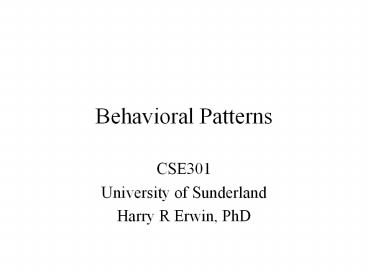Behavioral Patterns - PowerPoint PPT Presentation
1 / 15
Title: Behavioral Patterns
1
Behavioral Patterns
- CSE301
- University of Sunderland
- Harry R Erwin, PhD
2
Behavioral Patterns
- Chain of Responsibility
- Command
- Interpreter
- Iterator
- Mediator
- Memento
- Observer
- State
- Strategy
- Template Method
- Visitor
3
Chain of Responsibility
- Allows multiple classes to handle a request
without having to coordinate. Heavily used in
Java, particularly in exception handling. The
chain might be dynamically altered. - Approach
- Set up a chain of responsible classes or objects
and walk down the chain until a class claims the
request. - Often implemented as a tree.
- The chain has to be implemented using interfaces.
- Positives
- Decouples handlers
- Flexible
- Negatives
- No coordination
- Falling off the end of the chain or tree
4
Command
- Encapsulate a request as an object. Supports
queueing, logging, and undo operations. The Java
1.1 event model implements this. - Approach
- Encapsulate the request as an object.
- Positives
- Hides the private details of the request.
- Commands are first class objects.
- Allows priority queueing.
- Supports a macro or scripting language approach.
- Negatives
- Overhead
- Lots of little classes
5
Interpreter
- Some problems are best defined in terms of
statements in a language. The interpreter pattern
provides a grammar and a way of translating
statements. - Examples include scripting languages. Java
provides facilities for parsing XML and regular
expressions. - Positives
- The grammar is easy to change and extend.
- Interpreting simple languages is easy.
- Negatives
- Efficiency
- Only simple languages can be easily processed.
6
Iterator
- An iterator is an object that supports the
traversal of a collection. The interface between
an algorithm and a collection should be an
iterator. - Approach
- See the Iterator interface. Consider implementing
by using inner classes. - Positives
- Raises the level of abstraction without a major
performance penalty. - Negatives
- There are some esoteric traps to avoid if the
collection is simultaneously being modified. - Protected access
- Typecasting is necessary in Java
7
Mediator
- In a complex system, supporting
intercommunication between classes may become
tangled. A mediator is a switchboard. - Approach
- Forward messages to the appropriate objects via
the mediator object. The mediator usually handles
initialization as well. - Positives
- Loose coupling between objects
- The mediator encapsulates the business
relationships. - Negatives
- Potentially monolithic in complexity, producing a
maintenance burden. - Overhead
- Lack of reuse
8
Memento
- Can capture and externalize the state of objects
to allow them to be examined or restored later.
Used for undo/redo and also for database
transaction logging. - Approach
- Use a second class in the same package to capture
and restore the internal state. - Positives
- Needed for state machines.
- Needed for white-box testing and debugging.
- Negatives
- Object state can be complex and hard to capture.
- Potentially large amounts of data.
9
Observer
- Supports separation between model and view.
- Approach see Swing
- Positives
- Decouples observers from models
- Negatives
- Lack of coordination between observers. Who has
responsibility? - What sort of messages should be sent? Adapter
classes may be required.
10
State
- An object that has to appear to change its class
suggests the use of the state pattern - Approach
- Encapsulate the variable behavior in a state
attribute. To switch states, change the object
stored in the attribute. Keep prototypical states
stored in the state class. - Positives
- State machines are a good design solution
- Avoids large numbers of conditional statements
- Negatives
- Unless the prototype pattern is used, there can
be a lot of object creation. - Lack of function pointers in Java means that
there is significant overhead. - Tables often work better.
11
Strategy
- Sometimes you need to encapsulate a collection of
algorithms in a class hierarchy. The algorithms
are allowed to vary independently of the classes
using them. The choice of algorithm reflects
factors unknown until program execution. - Approach
- The strategy class objects are functorstheir
behavior is defined by a static member function
with a common name, but with behavior varying
among the subclasses. - Positives
- Elegant
- Effective
- Negatives
- The client code has to be able to choose a
strategy. - The signature of the functor may have to be quite
broad.
12
Template Method
- Define the skeleton of an algorithm, but defer
details to subclasses. Fundamental to Java. - Approach
- Abstract classes provide this capability.
- Positives
- Normal part of OO programming.
- Negatives
- Not as powerful as in C.
13
Visitor
- Sometimes you need to perform a common operation
on a number of class objects in multiple classes.
This can be useful in white-box testing. - Approach
- Move the behavior to an outside class the
visitor, which traverses the collection of
objects. The objects need to provide an
appropriate interface. The operation is done by
the visitor accessing the object interface, which
in return calls the polymorphic operation
provided by the visitor. - Positives
- Minimizes code duplication
- Makes adding new operations easy
- Negatives
- Arcane and inefficient.
- Adding new classes affected by the visitor is
hard. - The objects to be visited need to be kept in a
collection.
14
Examples from Book
15
Pattern ImportanceMore??Less
- Decorator
- State
- Iterator
- Façade
- Strategy
- Proxy
- Factory Method
- Adaptor
- Observer
- Template Method
- Composite
- Singleton
- Abstract Factory
- MVC
- Bridge
- Builder
- Chain of Responsibility
- Flyweight
- Interpreter
- Mediator
- Memento
- Prototype
- Visitor































